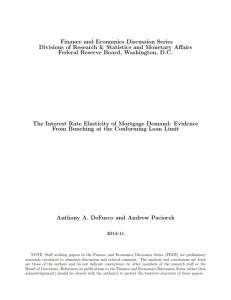Join getAbstract to access the summary!

Join getAbstract to access the summary!
Anthony A. DeFusco and Andrew Paciorek
The Interest Rate Elasticity of Mortgage Demand
Evidence From Bunching at the Conforming Loan Limit
Federal Reserve Board, 2014
What's inside?
Is your dream home worth a “jumbo loan”?
Recommendation
Most modern economies depend, to varying degrees, on the housing industry to generate growth. While reckless government promotion of home ownership can cause excesses such as those that happened in the United States, Spain and Ireland leading up to the 2008 housing bust, overly cautious policies can dampen economic development. As officials tweak the rules on mortgages to thwart prerecession extremes, it is important to understand how the costs of new regulations affect the housing and debt markets. While this paper may try too hard to find more answers than the data might bear, getAbstract applauds its bold attempt at addressing tough questions.
Summary
About the Authors
Anthony A. DeFusco is a doctoral student at The Wharton School. Andrew Paciorek is an economist with the Board of Governors of the Federal Reserve System.

















Comment on this summary